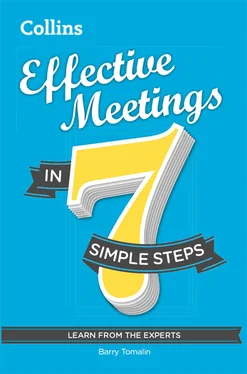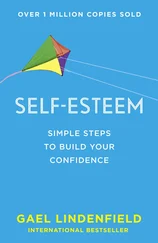contain people you need to meet or talk to
deal with things which interest you or you can learn from.
For all the rest, take a view.
Get a copy of the meeting invitation and the agenda. Does it meet one of your criteria above? If yes, try and go. If not, ask your line manager if you need to attend.
Learn to discriminate. Decide which meetings will be important or helpful to you. For the others, explain your workload to your line manager and ask if you can be absent. Ask yourself constantly: ‘What is my purpose for being here? Could I use this time better, doing something else?’
Most meetings can be summarised over the coffee machine. If you miss a meeting, ask a colleague: ‘Did I miss anything important?’
If you did miss something important, get a copy of the minutes. If necessary and appropriate, follow up with your own views.
Obviously, not all meetings are the same. The type of meeting will depend on its function. Let’s look at some of them.
These are fairly rare. They tend to be semi-public occasions and involve the paramount chief and various sub-chiefs. Each clan in the tribe is involved in praise songs and ‘death to our enemy’ chants, awards are handed out and there is some hospitality on hand. If you’ve attended an annual school prize-giving or sports day you’ll know what we’re talking about. In a company it’s usually called the AGM (Annual General Meeting), new product launch, or something like that. Why go? You go for the jamboree and the hospitality. It’s also a good chance to network, and if you’re to be honoured with a prize like ‘employee of the year’, it’s probably worth a look-in.
Weekly or monthly updates
These are usually project team and departmental meetings. Their function is to update on activities, check progress against deadlines, allocate responsibilities, troubleshoot problems and make sure everyone knows what they are supposed to be doing. Why go? You need to attend these. They’re important. If you can’t attend, make sure people know beforehand. ‘No shows’ are not well viewed. It’s a sign of disinterest or failure of responsibility. Neither are recommended qualities for promotion. So remember: if you can’t go, let the chair know. Beforehand.
Performance reviews are another type of meeting. You often have to prepare paperwork, and sometimes the outcome of this meeting affects your salary, bonuses and training opportunities.
These are single topic discussions with an open agenda where all ideas are welcome. The rule (not always observed) is that any idea, no matter how far-fetched, is worth voicing. The aim is to get ideas for future action, often in new areas of company development. Why go? They’re lively and fun and they help you get a feeling for other members of the group: how they think; what their priorities are. If you have something useful to contribute it’s also a great way to make an impression. One word of advice: never speak first. You’re better off keeping your powder dry until you know which way the wind is blowing. Then when you do speak, in favour or in opposition to what others are saying, you’ll make a stronger impact.
If these don’t sound relevant to you, avoid them whenever you can. They can range from how to economise on coffee machines to saving paper or other office matters. Enough said.
Let’s practise what we preach and have a brief summary of shorter meetings. Here are three ideas:
Meeting at 10.10 Most people expect ten o’clock. They wander in a few minutes late, get coffee or tea, find their seat, complain that there are no biscuits, and catch up on gossip. So the first ten minutes or so is actually wasted time. That’s why some meeting organisers start their meetings at an odd time. They start at ten minutes past ten, ignore latecomers and don’t recap for them. They get on with the agenda and finish when they say they will. If there is anything not discussed, they do it in a private meeting later or put it back to the next meeting.
Stand-up meetings That’s right. No one sits down. After half an hour or less, people are sagging – a great way to shorten a meeting, though not very comfortable.
Timed agenda Some meeting organisers put a duration against each point on the agenda, e.g. holiday time announcement (5 mins ). This used to be very popular but has fallen out of favour now. Still useful, though, if only as an indicator.
If you think short meetings are impossible, look at the agenda of the President of the United States: Affairs of State may be concluded in ten minutes. No time for chat there.
Not all meetings take place in an office. If you work in a factory or department store, team meetings and staff announcements will often be held on the factory or sales floor. How are they different? Most meetings will be shorter. Most people will be standing up. They will usually be run by the department head, team leader or, maybe, trade union official.
The atmosphere is likely to be much more informal. People will just stand around the speaker. Once the announcement is made, people can ask questions. Then, when it’s over, everyone simply goes back to work.
In many factories and department stores, team ‘huddles’ are popular. These are informal meetings at the beginning or end of the day to remind the team of important points and boost morale.
There’s a last type of meeting that takes place in public. This is when senior members of staff address the troops on more general policy issues. These might take place in the cafeteria or in another public space. Do go. It might be your only chance to see the boss in person!
Meetings start with an invitation. The invitation is usually an email, sent round to people to say the meeting will take place. The invitation will normally state:
Date
Time (start and finish)
Location (room/building, check the size/capacity of the room)
Participants in the meeting
Topic (what the key aim of the meeting is, e.g. management meeting, conference planning, work allocation on the shop floor, customer service procedure, etc.)
Contact person (the person arranging the meeting)
If the agenda is finalised, it’s a very good idea to attach it to the invitation.
See Step 2for more on invitations.
One of the key questions in any meeting is who should attend. There is a golden rule: as few as possible . And only those relevant to the outcome. Allowing everybody in is rarely effective in a meeting. You end up with dozens of ideas, hundreds of disagreements, no decisions and no clear way forward.
What are the outcomes of this approach?
time wasted
disaffected people
a demotivated department
It’s far better to decide what you want to achieve and who you think will help you achieve it, as well as those who might oppose it, though you need to listen to them. They often think of things you forget or warn you of possible dangers. Get these people in the meeting and focus on them.
Читать дальше














